The current furor about an alleged connection between climate change, CO2 emissions, and Australian fires finds no support in the scientific literature. According to scientists, rising CO2 concentrations reduce fire ignition and burned area. Further, both global-scale and Australian fires were far more pervasive during the colder Little Ice Age.
Here’s what the scientific literature has to say about fires and their connection to climate and CO2 concentrations.
1. “Elevated CO2 and warmer climate promote global total tree cover” and higher CO2 “leads to reduced fire ignition and burned area” (Chen et al., 2019).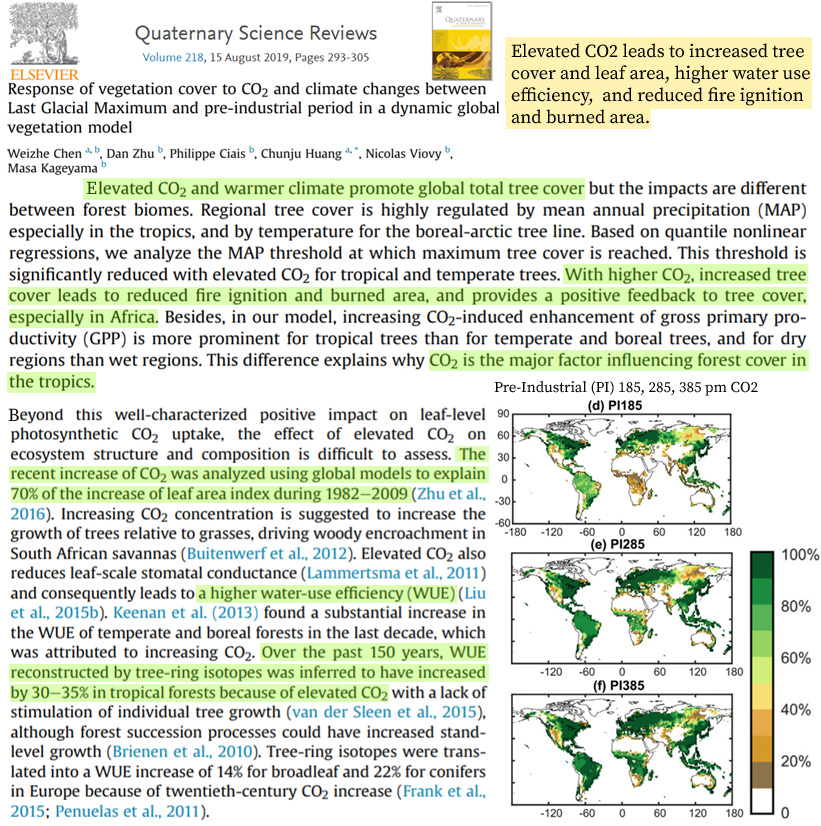
Image Source: Chen et al., 2019
2. Globally, fires were much more common during the colder Little Ice Age (Yang et al., 2007; Ward et al., 2018; Doerr and Santin, 2016), or before 1900. Fire frequencies have been rapidly declining as CO2 emissions began abruptly rising in the 1940s.
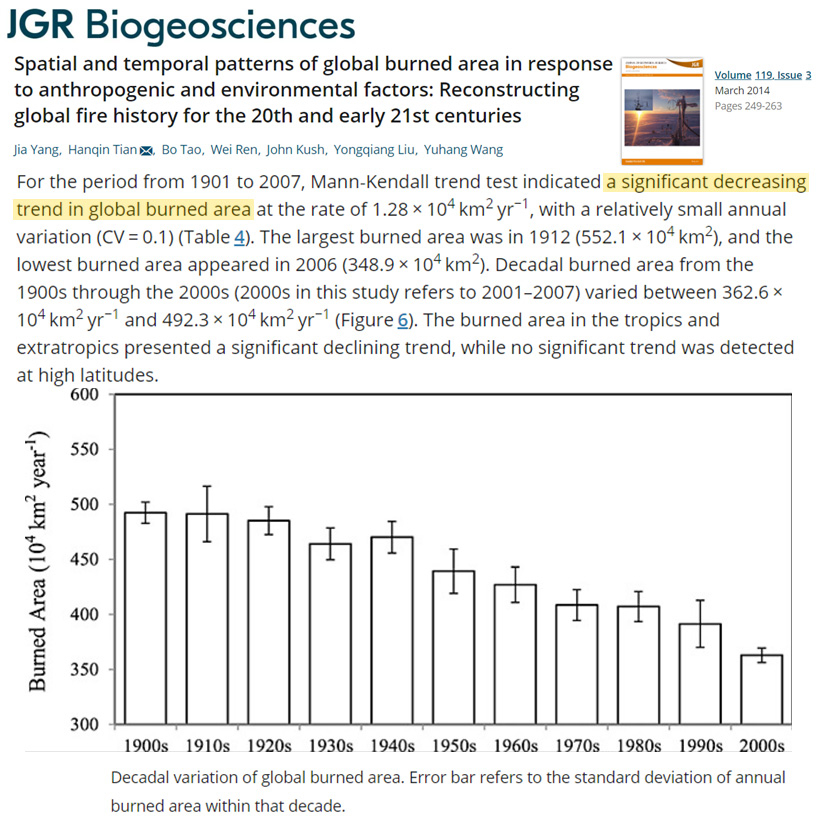
Image Source: Yang et al., 2007
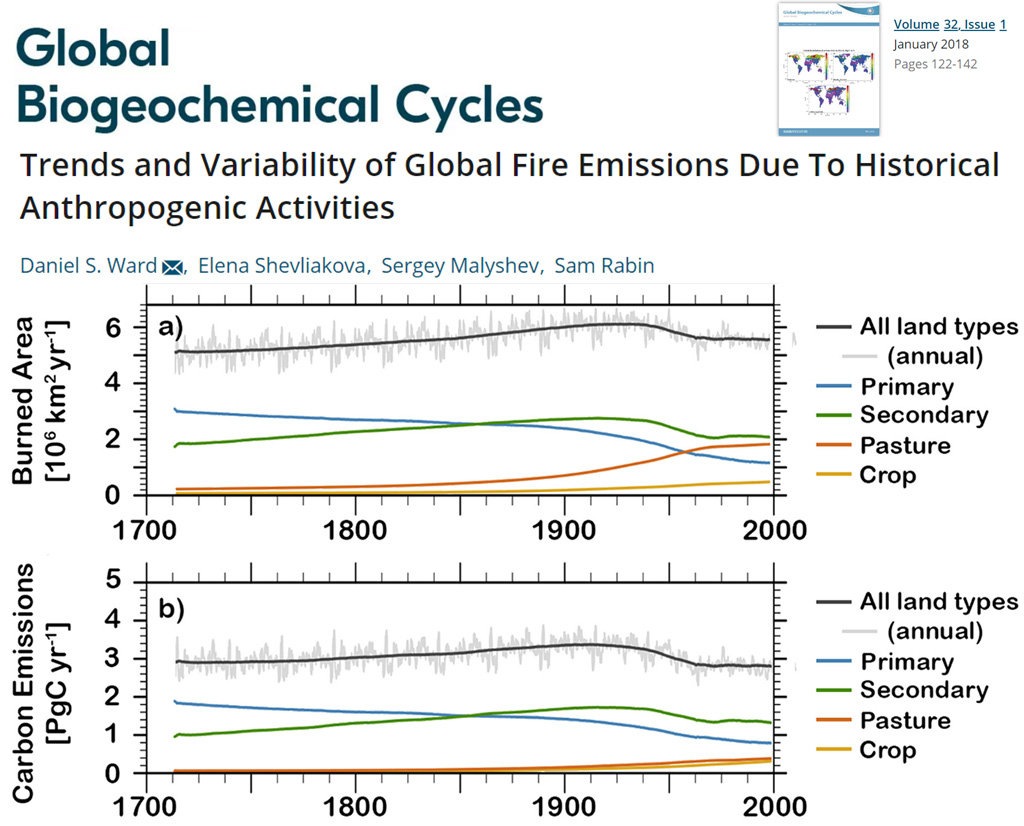
Image Source: Ward et al., 2018
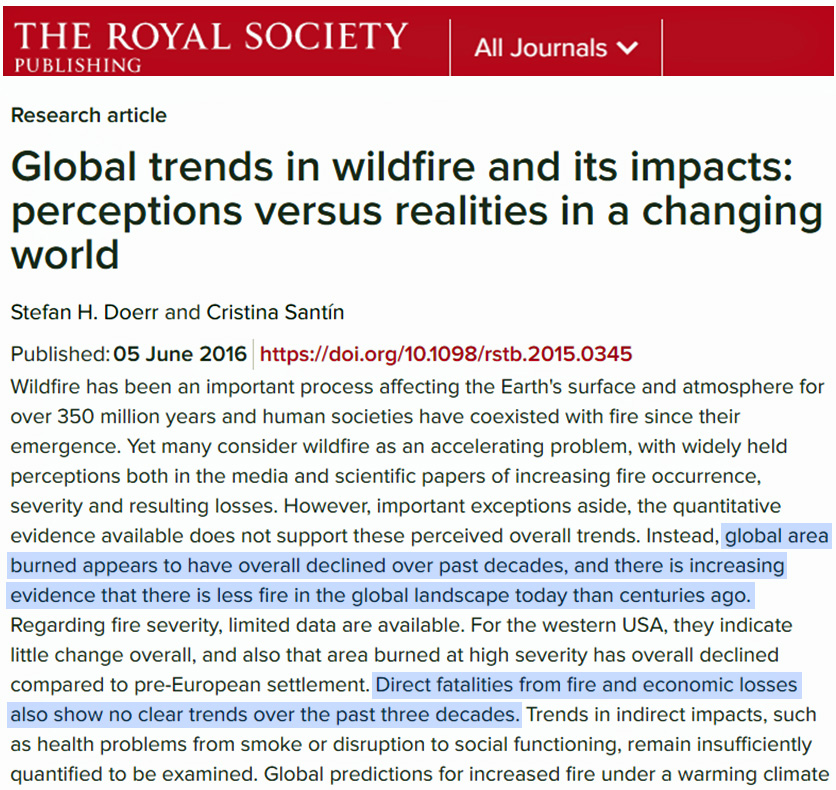
Image Source: Doerr and Santin, 2016
3. There has been a continued decline in global fire since the 21st century began (Earl and Simmonds, 2018).
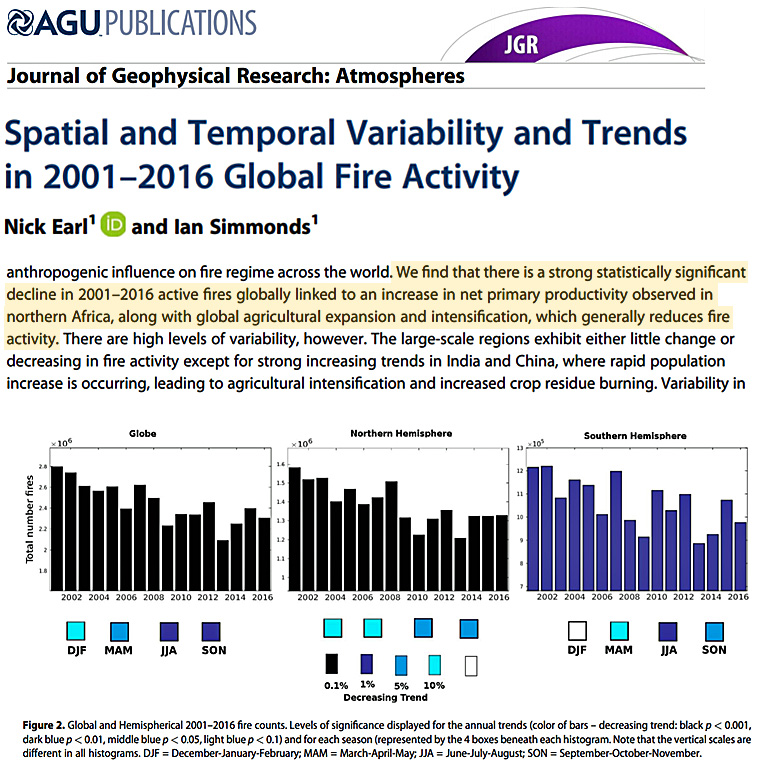
Image Source: Earl and Simmonds, 2018
4. Australia’s mainland experienced far more pervasive fire during the 1800s to early 1900s, or the Little Ice Age. There has been an abrupt decline in fire activity for the entire Australasian region in the last 50 years (Mooney et al., 2011).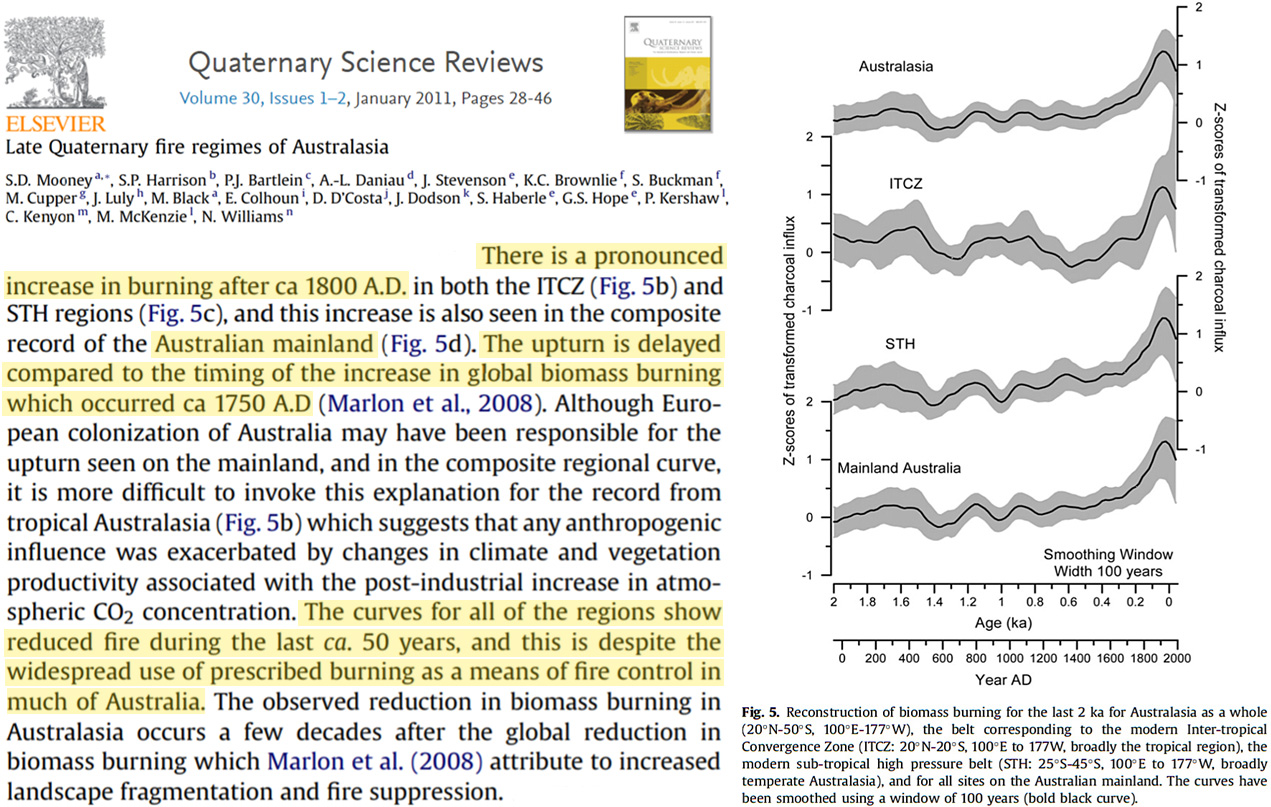
Image Source: Mooney et al., 2011
5. The “assumed positive relationship between drier climates and biomass burning” is not supported by wetter Little Ice Age climates coeval with more burned area in Australia (Tibby et al., 2018).
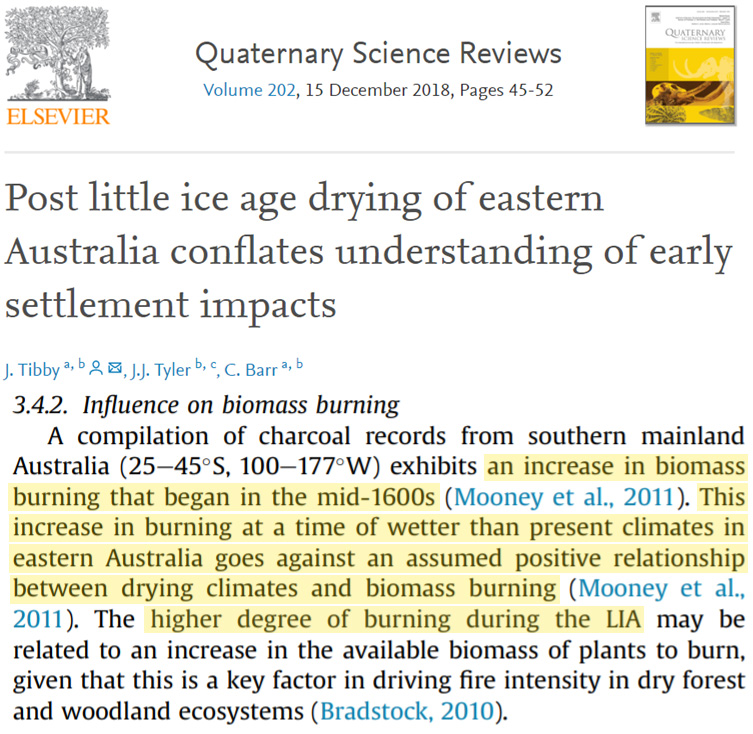
Image Source: Tibby et al., 2018
6. Australia, like the globe, has neither become wetter or drier over the last 3 decades. There is “no evidence” global precipitation patterns have been been altered by global or regional temperature changes (Nguyen et al., 2018).
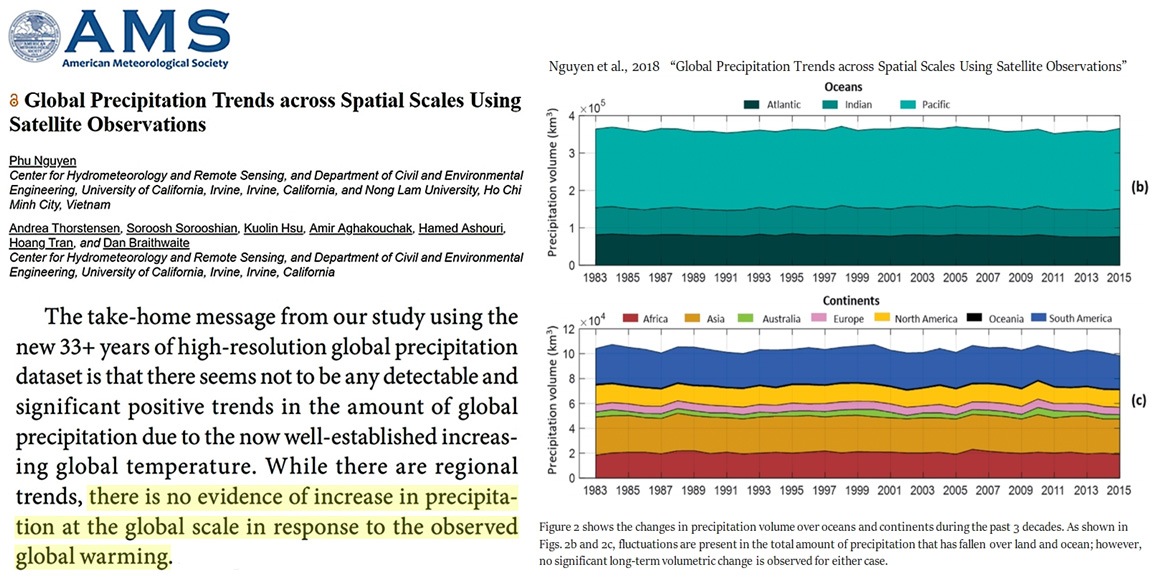
Image Source: Nguyen et al., 2018
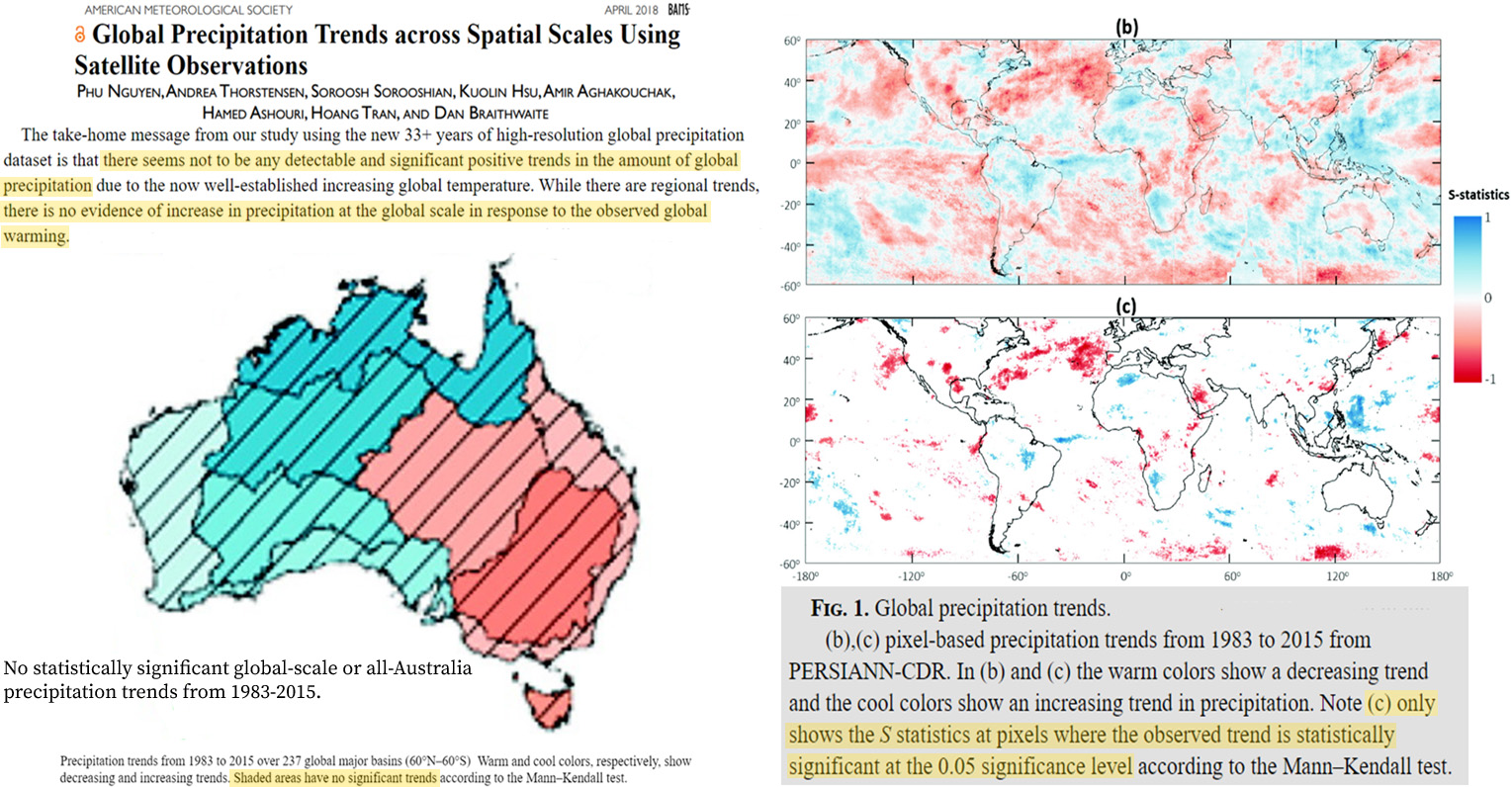
Image Source: Nguyen et al., 2018
To summarize, the scientific literature does not lend support to claims fires in Australia are connected to warming, rising CO2 emissions, dry climates, or wet climates.
If there were a potential climate linkage, it would be that enhanced fire activity arises in cooler climates.
In other words, there is no apparent link to anthropogenic global warming that can be supported by evidence found in the scientific literature.





However,
Australia has vast numbers of eucalyptus [gum] trees. These trees shed large quantities of bark, and leaves. Which are then readily burned if ignited by some means.
Who knows, maybe there is a correlation. Elevated co2, if it produces more plant growth, well, then maybe there becomes more tree litter to burn. And then there is the highly flammable aspect of the eucalyptus leaves still on the trees. So, if the leaves are growing well ……
Just saying.
Thanks for this timely list, Pierre.
I’ve been looking for such a list for a while now. I’m in Aus (yes, one of these fires was within 10m of my home) and the MSM propaganda is trying to downplay the various oceanic pulses (IOD, ENSO, SAM) and replace them with atmospheric CO2.
So this article is extremely timely.
There is a very simple case to answer for the bushfires in the State of Victoria. Victoria’s recommended annual planned burn target agreed to from the Royal Commission into the 2009 bushfires is 390,000Ha.
Actual planned burn area:
2018-19- 130,000 Deficit- 260.000
2017-18- 74,728 Deficit- 315,272
2016-17- 125,052 Deficit- 264,948
2015-16- 197,940 Deficit- 192.060
2014-15- 234,614 Deficit- 36,674
Cumulative deficit over the last 5 years totals 1,068,954Ha. Planned burns only achieved 45% of the target over the last 5 years. An honourable State premier would stand down over such a dismal performance on such a critical target that resulted in so much property loss.
Every Royal Commission report into bushfires in Australia makes recommendations on planned burns to reduce fuel load. The government of the time adopts the recommendations then gradually forget them as the country gets greener and fire risk diminishes; until the next catastrophic fire and next Royal Commission.
One aspect that has worked well this fire season is the warning system that came out of the 2009 report as there have been few occupier deaths given the extent of property loss.
Australian farmers and graziers are being paid to return their pastures back to bushland. So far there have been 68M carbon credit units issued at an average price of $16 (>$1bn). Most of these credits have gone to graziers returning grazed land to bushland. That bushland just becomes another fire risk and increases the continuity of fuel.
Local councils have highly punitive regulations for property owners taking their own actions to control fuel on their property. It is almost impossible to collect dead wood from public lands for risk of high fines. Planned burns are considered inconvenient and difficult to organise. These factors all work toward increased fuel that is ready to explode when conditions are right.
This is an excellent post Rick. I was involved in the Ash Wednesday bushfires
evacuation, if you could call it that (people just fled if they could) immediate post recovery (there were no plans) and at that time there was no warning system. The fires hit the Dandenong Ranges area quickly and developed into a huge fireball that took all before it. The ground was still so hot 5 days later that you could only get in with fire boots. People were in shock for days and weeks.This experience and the community response which I helped co-ordinate were written up and fed into the first review out of which developed DISPLAN the States emergency disaster co-ordination plan and the bushfire inquiry. Regrettably many of the preventative recommendations such as clearing and road access have gone by the wayside as councils have been taken over by the greens and state governments have neglected their duties in preference to pursuing the green vote and UN Agenda 21 goals which are disastrous for Australian bushfire management and prevention.
“To summarize, the scientific literature does not lend support to claims fires in Australia are connected to warming, rising CO2 emissions, dry climates, or wet climates.”
To quote the classic Australian movie, The Castle, “it’s the vibe” …
https://www.youtube.com/watch?v=nMuh33BMZYY
Out on the patio we’d sit,
And the humidity we’d breathe,
We’d watch the lightning crack over canefields
Laugh and think, this is Australia.
Sounds of Then (This Is Australia)
https://www.youtube.com/watch?v=q7WyYawrXKY
Check it out!
https://www.frontiersin.org/articles/10.3389/fpls.2014.00749/full
Modern flammable ecosystems include tropical and subtropical savannas, steppe grasslands, boreal forests, and temperate sclerophyll shrublands. Despite the apparent fiery nature of much contemporary vegetation, terrestrial fossil evidence would suggest we live in a time of low fire activity relative to the deep past. The inertinite content of coal, fossil charcoal, is strikingly low from the Eocene to the Pleistocene and no charcoalified mesofossils have been reported for the Cenozoic.
Fire shapes the dominant growth forms in a large proportion of the world’s ecosystems. In the tropics and subtropics, savannas occur over vast areas accounting for more than half the world’s annual burnt area (van der Werf et al., 2010). At high latitudes, boreal forests cover nearly a fifth of the vegetative land surface of the world and burn regularly. Flammable shrublands are most apparent in Mediterranean climate regions but also occur elsewhere especially where the climate is unsuitable for C4 grasses.
The southern two thirds of Australia, for example, are dominated by flammable shrublands often with emergent eucalypt trees. In all these regions closed forests that resist burning occur in a bi-stable state with the shrublands suggesting that climate alone does not explain vegetation structure. The dawning recognition that fire is a major factor shaping global biome distribution has emerged in little over a decade from diverse studies (e.g., Bond et al., 2005; Bowman et al., 2009; Krawchuk et al., 2009).
[…] https://notrickszone.com/2020/01/13/scientists-rising-co2-reduces-fires-australian-global-fires-were… […]